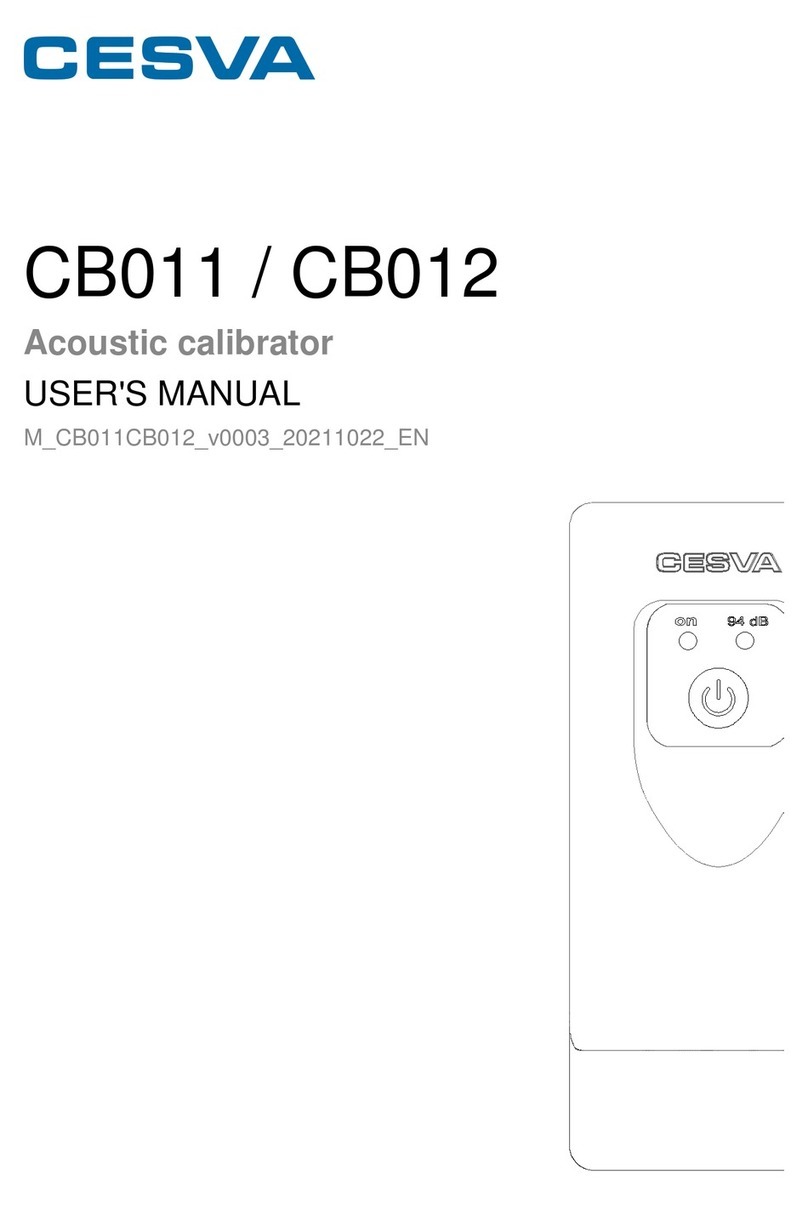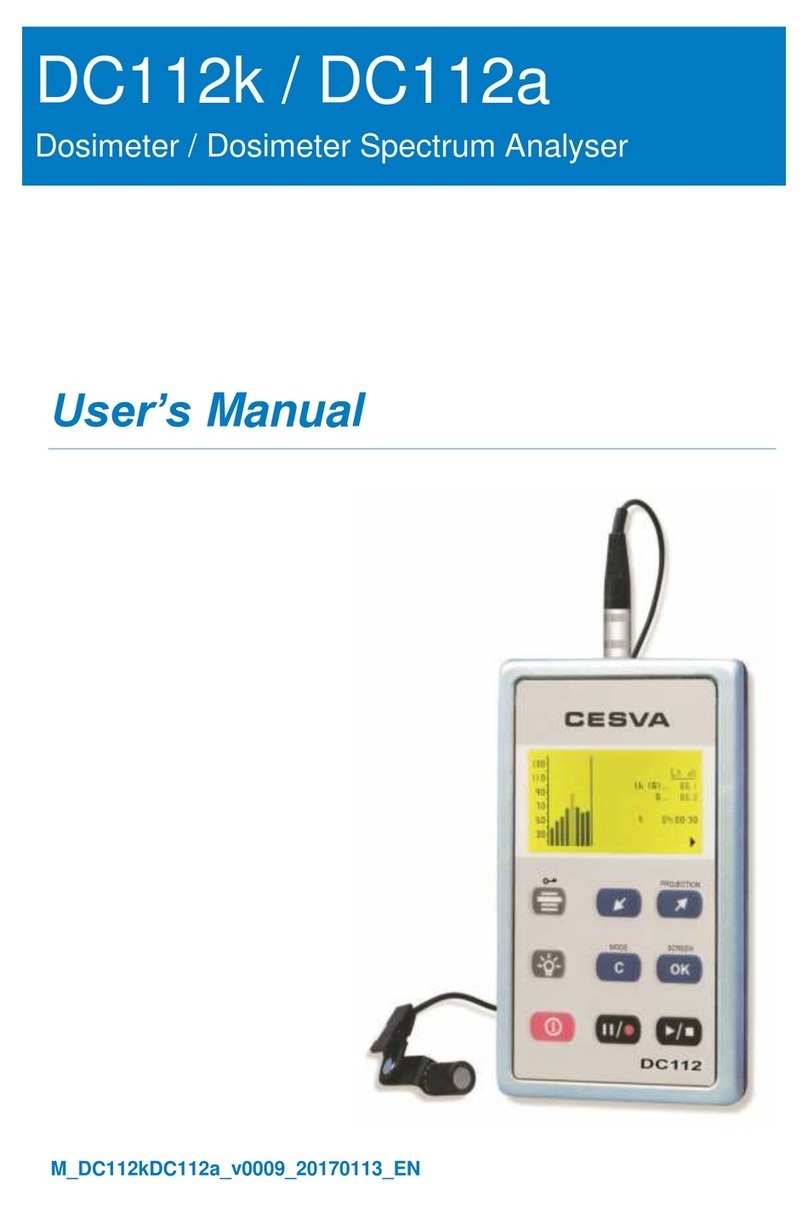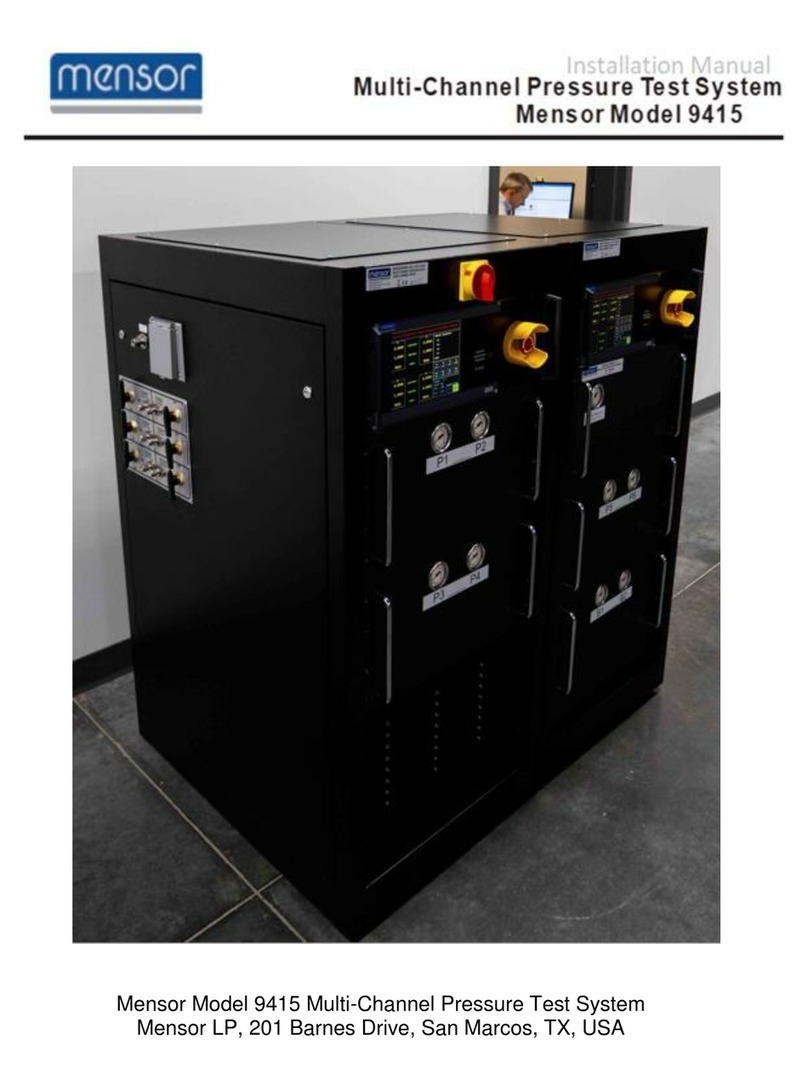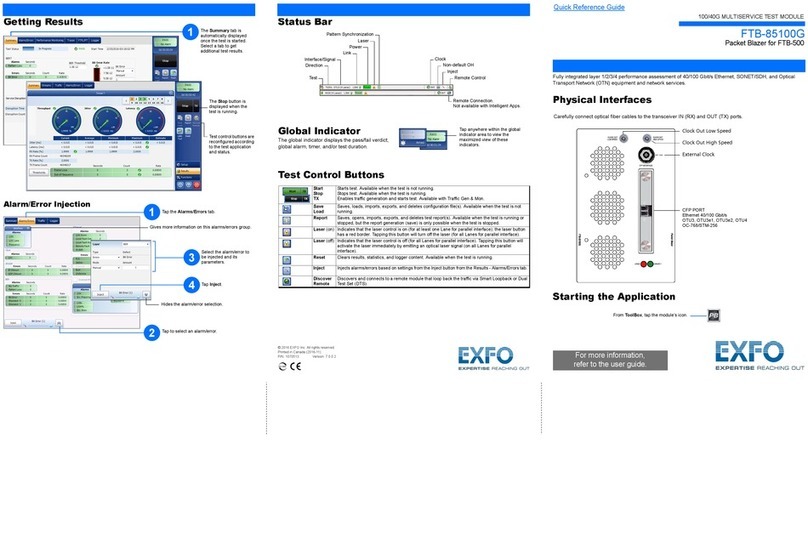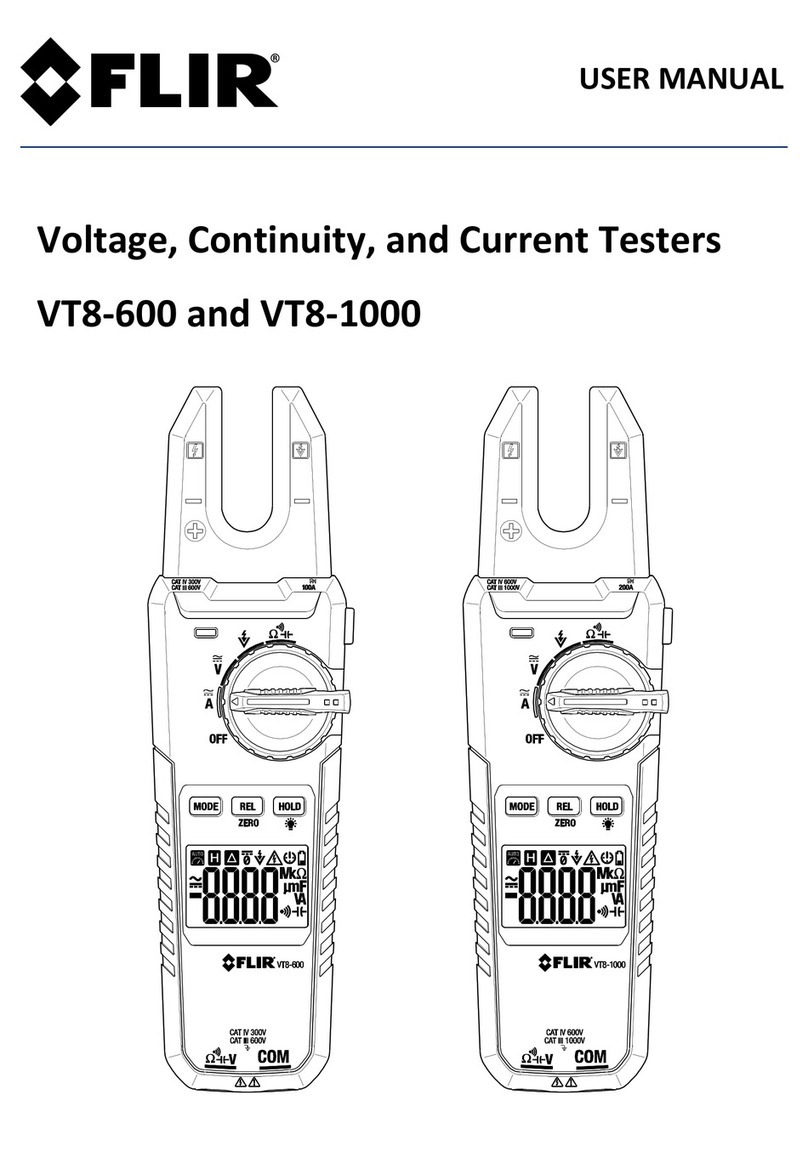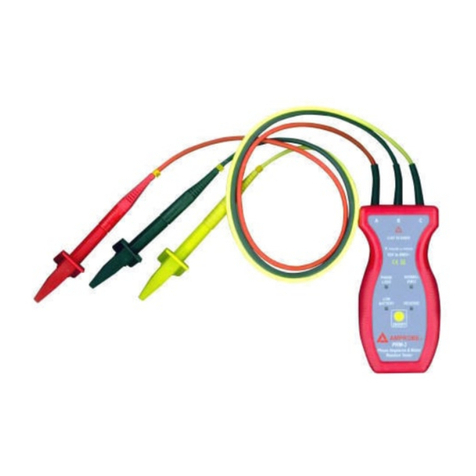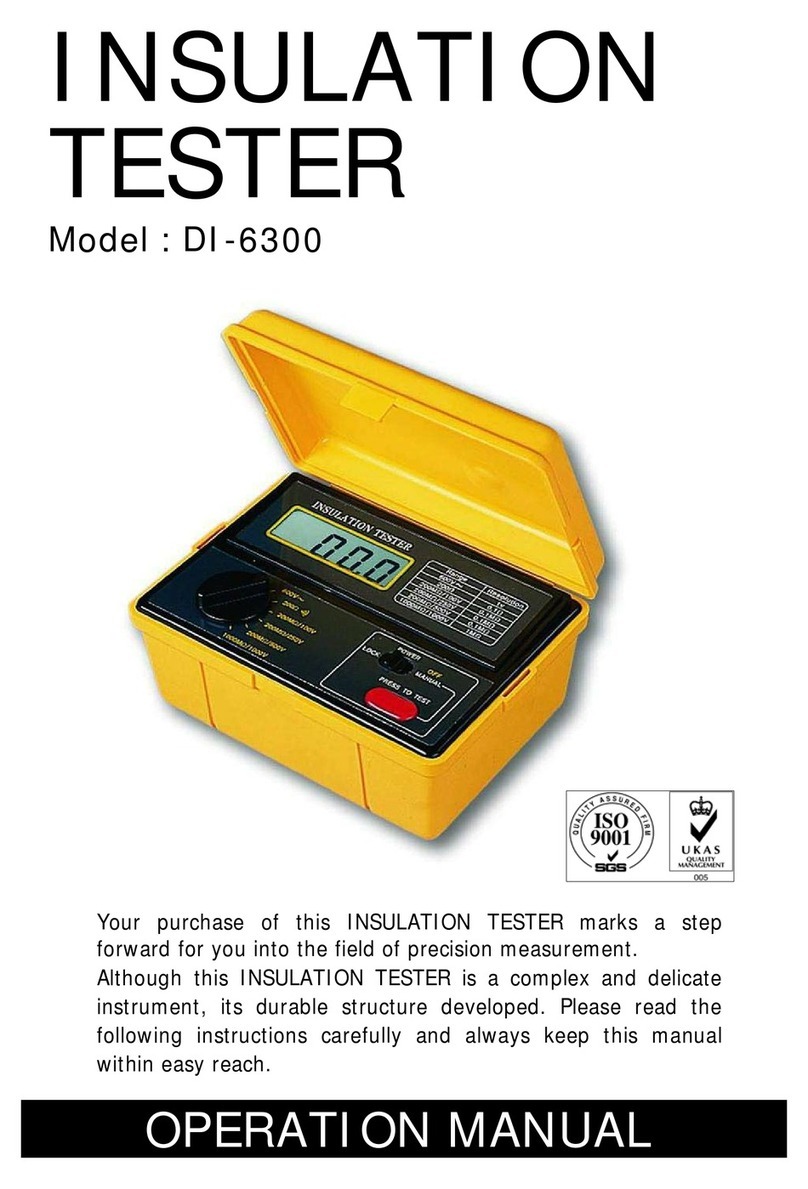CESVA CB006 User manual

CB006 / CB004
Calibrador acústico
Acoustic calibrator
Calibreur acoustique
Calibrador acústico
M_CB006CB004_v0027_20170227_ES_EN_FR_PT
Manual del usuario
User’s manual
Manuel d’instructions
Manual do utilizador

MANUAL DEL USUARIO
USER’S MANUAL
BENUTZERHANDBUCH
MANUEL D'INSTRUCTIONS
MANUALE D’USO
MANUAL DE L’USUARI

CB006 / CB004
Manual de instrucciones
1
ESPAÑOL
CONTENIDO
1. DESCRIPCIÓN GENERAL............................................................................................... 2
2. CONTROLES Y ELEMENTOS ......................................................................................... 2
3. PUESTA EN MARCHA..................................................................................................... 4
3.1 Método de verificación ................................................................................................. 4
3.2 Modo de funcionamiento permanente .......................................................................... 6
3.3 Cambio de la pila ......................................................................................................... 6
3.4 Tipo de pila .................................................................................................................. 6
4. ESPECIFICACIONES TÉCNICAS.................................................................................... 7
5. NORMAS.......................................................................................................................... 8
6. CERTIFICADOS ............................................................................................................... 8
7. NOTAS.............................................................................................................................. 8

2
1. DESCRIPCIÓN GENERAL
Una buena verificación de los instrumentos destinados a la medición de sonido audible es
primordial efectuarla antes y después de cada serie de mediciones. Los calibradores
acústicos modelos CB006 y CB004 representan un medio preciso y económico
para realizarla.
Ambos calibradores son portátiles y de muy fácil manejo, lo que los hace útiles para la
verificación de sonómetros y dosímetros tanto en el punto de medición como en laboratorio.
No necesitan la aplicación de correcciones para condiciones ambientales.
Pueden utilizarse con cualquier micrófono susceptible de ser verificado en una cavidad
cerrada y con diámetro de ½". Están recomendados para los micrófonos C-130,
C-250, P-05 y P007.
El CB006 y el CB004 generan un nivel de presión acústica de 94 dB (1 Pa = 1 N/m2) y
utilizan 1 kHz como frecuencia de verificación, eliminando la necesidad de correcciones
debidas a las ponderaciones frecuenciales, ya que estas no afectan a esta frecuencia.
El CB006 cumple la norma IEC 60942:2003 clase 1 y el CB004 cumple la norma IEC
60942:2003 clase 2.
El CB006 ha sido especialmente diseñado para verificar dosímetros y sonómetros clase 1 y
clase 2 y el CB004 para verificar dosímetros y sonómetros clase 2.
Tanto el CB006 como el CB004 se manejan con solo un botón. Al pulsarlo el calibrador
genera un tono de 94 dB a 1 kHz.
Para alargar la vida de las pilas, a los 5 minutos el calibrador se apaga automáticamente.
También tiene un modo de funcionamiento permanente para utilizarlo durante periodos más
largos.
2. CONTROLES Y ELEMENTOS
En la siguiente figura se muestran las partes más importantes de los calibradores CB006 y
CB004:
1) Botón encendido: Botón para encender y apagar el calibrador.
2) Marca CE: Marca de conformidad europea.
3) Marca WEEE: Símbolo que indica la recogida selectiva de aparatos eléctricos y
electrónicos.
4) Indicador de estado de la pila: Al poner en marcha el calibrador debe iluminarse el
LED verde.
5) Compartimiento de la pila: Compartimiento para la pila.
6) Tapa protectora de la pila: Retirarla para cambiar la pila.
7) Tornillo fijador: Tornillo para fijar la tapa protectora de la pila.

CB006 / CB004
Manual de instrucciones
3
7
5
6
4
1
2
3

4
3. PUESTA EN MARCHA
3.1 Método de verificación
1) Inserte el instrumento en el calibrador, introduciendo el micrófono en la cavidad de
verificación y asegurarse que ha entrado hasta el fondo de la cavidad y en posición
paralela al eje del calibrador. Puede ser que cueste un poco debido a que el calibrador
debe ajustarse perfectamente al micrófono. No introduzca el instrumento bruscamente,
el micrófono podría dañarse. También asegúrese de que el pequeño agujero que se
encuentra al lado de la cavidad no está obstruido, ya que esto podría dañar el
micrófono.
2) Ponga en marcha el calibrador mediante el botón de encendido (1). El indicador de
estado de la pila se encenderá indicando que el calibrador está encendido.
3) Espere a que el nivel de presión acústica generado por el calibrador se estabilice,
típicamente 3 segundos.
4) Ponga en marcha el instrumento a verificar. En caso que sea necesario, ajuste la
sensibilidad de este para una indicación correcta del nivel efectivo de verificación (nivel
generado por el calibrador + correcciones).
5) El valor efectivo de verificación se obtiene corrigiendo el nivel generado por el calibrador
(94 dB) con el siguiente factor:

CB006 / CB004
Manual de instrucciones
5
a. Factor de corrección presión a campo libre del micrófono a la frecuencia de 1
kHz: En el caso que el instrumento a verificar este diseñado para medir en
campo libre se debe aplicar este factor. Para instrumentos diseñados para medir
en campo de presión no es necesaria ninguna corrección. Este factor es igual a
cambiar de signo la corrección presión a campo libre a 1 kHz que se indica en el
manual de instrucciones del instrumento. En la siguiente tabla se indican los
factores de corrección para diferentes micrófonos y para dos
micrófonos utilizados habitualmente en pruebas de laboratorio.
Marca
Modelo
Factor de corrección
Nivel efectivo de
verificación
CESVA
C-250
- 0,1 dB
93,9 dB
CESVA
C-130
- 0,1 dB
93,9 dB
CESVA
P-05
- 0,1 dB
93,9 dB
CESVA
P007
- 0,1 dB
93,9 dB
B&K
4134
0 dB
94,0 dB
B&K
4180
0 dB
94,0 dB
EJEMPLO: suponga que quiere verificar un sonómetro SC310 con
micrófono C-130.
Obtenga el valor de la corrección presión a campo libre del micrófono C-130 a 1 kHz
del manual del instrumento. Esta es 0,1 dB.
El valor del factor de corrección presión a campo libre a la frecuencia de 1 kHz será
pues -0,1 dB.
Valor efectivo de verificación = nivel generado por el calibrador + factor de corrección
presión a campo libre a la frecuencia de 1 kHz Valor efectivo de verificación = 94
+ (-0,1 dB) = 93,9 dB.
6) Al acabar la verificación, parar el calibrador pulsando el botón de encendido (1).
NOTA 1: El calibrador se apagará automáticamente transcurridos 5 minutos después de
encenderse para preservar la pila.
NOTA 2: Para que el calibrador funcione como es debido el ruido ambiente debe ser inferior
a 80 dBA.
NOTA 3: Consulte el apartado de verificación del manual de instrucciones del instrumento.

6
3.2 Modo de funcionamiento permanente
Para ciertas aplicaciones puede ser necesario tener el calibrador encendido de manera
permanente. Para ello, encienda el calibrador manteniendo pulsado el botón de encendido
durante tres segundos.
Suelte el botón de encendido y el led indicador de estado de la pila (4) parpadeará durante
un instante, indicando que el calibrador está funcionando en modo permanente, y
seguidamente quedará fijo. Pulse el botón de encendido (1) para apagar el calibrador.
3.3 Cambio de la pila
Los calibradores CB006 y CB004 ambos utilizan una pila alcalina de 9 V.
1) Con la ayuda de un destornillador o una moneda desenrosque el tornillo fijador (7).
2) La pila se puede ahora reemplazar sin ninguna dificultad. Presione la pila contra el
muelle y tire hacia arriba, sujetando la pila por el lado contrario. Inserte la pila
respetando la polaridad.
Ponga en marcha el calibrador y verifique que el LED indicador del estado de la pila (4) se
ilumina.
3.4 Tipo de pila
La pila tiene que ser del tipo 6LR61 (NEDA 1604 en EEUU y partes de Asia, PP3 en el
Reino Unido) y alcalina de 9V de larga duración. Cuando el voltaje de la pila este por debajo
de 6,4 V el calibrador no se encenderá. Si el voltaje de la pila está entre 6,6 V y 6,4 V el
indicador de estado de la pila (4) destellará, indicando el bajo voltaje de la pila. Una pila
descargada puede llegar a encender el calibrador, pero pronto disminuirá su voltaje y el
calibrador se apagará o indicará que la pila está gastada.

CB006 / CB004
Manual de instrucciones
7
4. ESPECIFICACIONES TÉCNICAS
Especificaciones técnicas
Frecuencia
1kHz ± 1%
Nivel de presión acústica
94,0 dB re 20μPa
Especificación
CB006 -IEC 60942:2003 Clase 1
UNE-EN 60942:2005 Clase 1
CB004 -IEC 60942:2003 Clase 2
UNE-EN 60942:2005 Clase 2
Distorsión
Inferior a 2 %
Humedad relativa de funcionamiento
25 a 90 % Humedad relativa
Presión estática de funcionamiento
65 kPa a 108 kPa
Temperatura de funcionamiento
-10oC a +50oC Clase 1
0º C a +40ºC Clase 2
Temperatura de almacenamiento
-20oC a +60oC
Volumen efectivo
6,19 cm30,2 cm3
Diámetro cavidad
0,525 pulgadas
Pila
1 x 9V 6LR61 (Neda 1604)
Duración pila
Aproximadamente 15 horas con funcionamiento
continuo
Tensión de funcionamiento
9 V Nominal (10 V máximo, 6,4 V mínimo)
Peso con pila
185 g
Dimensiones
135 mm x Ø48 mm
El modo normal de funcionamiento es con el calibrador encendido.
El equipo produce la mayor emisión de radiofrecuencia con el equipo encendido (led
indicador de estado (4) encendido).
El calibrador sigue funcionando después de ser expuesto a descargas por contacto de
hasta 4 kV y descargas aéreas de hasta 8 kV, tanto para voltajes positivos como
negativos referidos a tierra.
El calibrador cumple los requisitos de la norma IEC 60942:2003 para una intensidad de
campo electromagnético eficaz sin modular de 10 V/m.
La máxima susceptibilidad a campos de alimentación eléctrica y radiofrecuencia se
encuentra con la cavidad orientada lejos del emisor, compartimiento de pilas hacia la
mesa, polarización horizontal de la antena y calibrador encendido.

8
5. NORMAS
UNE-EN 60942:2005 Clase1 (CB006); UNE-EN 60942:2005 Clase2 (CB004)
IEC 60942:2003 Clase1 (CB006); IEC 60942:2003 Clase2 (CB004)
, como fabricante de aparatos eléctricos o electrónicos le informa que el producto que
usted ha adquirido ha sido puesto en el mercado después del 13 de agosto de 2005 y que cumple
con las directivas 2002/96/CE y 2003/108/CE sobre residuos de aparatos eléctricos o electrónicos
(WEEE Waste from Electical and Electronic Equipment).
Asimismo, el producto incorpora el siguiente símbolo, el cual indica que éste está
sujeto a recogida selectiva.
6. CERTIFICADOS
Certificados
Evaluación de la conformidad mediante la siguiente combinación de módulos:
Examen de modelo (Módulo B)
Declaración de conformidad con el modelo basado en la garantía de calidad del proceso de
fabricación (Módulo D)
De acuerdo con la Orden ITC/2845/2007.
(Puede descargar una copia del certificado, en el apartado de metrología de la página web
www.cesva.com)
El CB006 y CB004 disponen del certificado de aprobación de modelo emitido por el
laboratorio alemán PTB (Physikalisch-Techische Bundesanstalt)
Marca . Cumple la directiva de baja tensión 73/23/CEE y la directiva CEM 89/336/CEE
modificada por 93/68/CEE.
7. NOTAS
Si su unidad dejase de cumplir cualquiera de estas especificaciones (por avería, golpes,
etc.) diríjase al servicio oficial más próximo para una verificación, ajuste o
reparación.

CB006 / CB004
User’s manual
9
ENGLISH
CONTENTS
1. GENERAL DESCRIPTION..............................................................................................10
2. PARTS AND CONTROLS...............................................................................................10
3. OPERATION ...................................................................................................................12
3.1. Checking method.......................................................................................................12
3.2. Permanent-on Mode...................................................................................................13
3.3. Battery replacement...................................................................................................14
3.4. Battery type................................................................................................................14
4. TECHNICAL SPECIFICATIONS .....................................................................................15
5. STANDARDS..................................................................................................................16
6. CERTIFICATES...............................................................................................................16
7. FURTHER INFORMATION AND SERVICING.................................................................16

10
1. GENERAL DESCRIPTION
Accurate checking of sound level measuring equipment is essential before and after each
series of measurements sound calibrators CB006 and CB004 provide a cost
effective yet accurate means of achieving this.
Both calibrators are portable, user-friendly instruments, which makes them ideal to check
sound level meters and sound dose meters on the measurement site or in the laboratory.
They do not need any corrections for environmental conditions.
They may be used with any microphone suitable for closed coupler checking and of ½"
diameter. It is advisable to use them with microphones models C-130, C-250, P-
05 and P007.
The CB006 and the CB004 generate a sound level of 94 dB (1 Pa = 1 N/m2) and use 1 kHz
as testing frequency, eliminating the need for corrections due to frequency weightings, as
they are unaffected at this frequency.
The CB006 complies with norm IEC 60942:2003 class 1 and the CB004 complies with norm
IEC 60942:2003 class 2.
The CB006 has been specially designed to test class 1 and class 2 dosimeters and sound
level meters and the CB004 to test class 2 dosimeters and sound level meters.
Both the CB006 and the CB004 are operated with a single button. When it is pressed, the
calibrator generates a tone of 94 dB at 1 kHz.
In order to increase the battery life, the calibrator switches off automatically after 5 minutes. It
also has a permanent ON mode, to enable it to be used for longer periods of time.
2. PARTS AND CONTROLS
In the following figure, the principal parts of the CB006 and CB004 calibrators are shown:
1) Power button: Button for switching the calibrator on and off.
2) CE Mark: European approval mark.
3) WEEE Mark: Symbol indicating separate collection for electrical and electronic
collection.
4) Battery state indicator: When the calibrator is on the indicator (green LED) must light.
5) Battery compartment: Space where the battery should be inserted.
6) Battery cover: Cover for protecting the battery.
7) Retaining screw: Screw for fixing the battery cover to the calibrator.

CB006 / CB004
User’s manual
11
7
5
6
4
1
2
3

12
3. OPERATION
3.1. Checking method
1) Insert the instrument into the calibrator, introducing the microphone into the checking
cavity. Make sure the microphone reaches the bottom of the cavity and is parallel to the
calibrator axis. This may require a little effort since the sound level meter must fit exactly
into the calibrator. Insert the instrument gently; otherwise you might damage the
microphone. Also ensure that the small bleed-hole next to the microphone cavity is not
blocked as this could cause damage to the microphone.
2) Turn on the calibrator by pressing the power button (1). The indicator will illuminate to
show that the unit is operating.
3) Wait until the sound pressure level generated by the calibrator is stabilized, typically 3
seconds.
4) Turn on the instrument to be checked. Where applicable, adjust the sensitivity of the
instrument to obtain a correct reading of the effective checking level, (level generated by
the calibrator + correction factors).
5) The effective checking level is obtained by correcting the level generated by the
calibrator (94 dB) with the following factor:
a. Pressure to free field correction of the microphone at 1 kHz factor: This factor
must be applied when the instrument to be checked is designed to measure in
free field. It is not necessary for instruments designed for measuring in a
pressure field. This factor is equal to changing the sign to the pressure to free
field correction at 1k Hz that is indicated in the user’s manual of the instrument.
The following table shows the factors to apply to some microphones
and for two microphones commonly used in laboratory tests.

CB006 / CB004
User’s manual
13
Make
Model
Correction factor
Effective checking
level
CESVA
C-250
- 0.1 dB
93.9 dB
CESVA
C-130
- 0.1 dB
93.9 dB
CESVA
P-05
- 0.1 dB
93.9 dB
CESVA
P007
- 0.1 dB
93.9 dB
B&K
4134
0 dB
94.0 dB
B&K
4180
0 dB
94.0 dB
EXAMPLE: you have to check an SC310 sound level meter with a C-130
microphone.
First, you must obtain the value of the pressure to free field correction at 1 kHz of the
C-130 microphone from the user’s manual of the instrument. This is 0.1 dB.
The value of the pressure to free field correction at 1 kHz factor is -0.1 dB.
Effective checking level = level generated by the calibrator + pressure to free field
correction at 1 kHz factor Effective checking level = 94 + (-0.1 dB) = 93.9 dB.
6) When finishing the test, press the power button (1) again and the indicator will go off
to show that the unit is switched off.
NOTE 1: The calibrator will automatically switch off after 5 minutes to preserve battery
power.
NOTE 2: In order for the calibrator to operate as intended, the ambient acoustic noise level
should be no greater than 80 dBA.
NOTE 3:Consult the chapter on checking of the user’s manual of the instrument.
3.2. Permanent-on Mode
For some applications there may be a need to have the calibrator switched on continuously.
To allow for this, the calibrator can be turned on by pressing and holding the power button for
three seconds.
Release the button and the indicator (4) will flash for a short time to show that the unit is in
permanent-on mode, and afterwards will remain constant. Press the power button (1) to
switch off the calibrator.

14
3.3. Battery replacement
The CB006 and CB004 acoustic calibrators use a single 9 V alkaline battery.
1) Unscrew the screw (7) holding the battery cover on, using a coin.
2) The battery can now be eased out of its holder and replaced. The battery should be
eased out terminal side first by pushing against the spring at the other end. Ensure that
the battery is inserted with the correct polarity with the negative terminal at the contact
with the larger cut-out.
Turn on the calibrator and check that the battery state indicator (4) lights.
3.4. Battery type
The battery should be an alkaline battery type 6LR61, called NEDA 1604 in the USA and
parts of Asia. It is often called PP3 in the UK. The battery is 9 V when new and will operate
the calibrator down to 6.4 V. When the battery voltage is below 6.6 V but above 6.4 V, the
battery state indicator (4) will flash to indicate that the battery voltage is low. When the
battery voltage is below 6.4 V the calibrator will not turn on. A discharged battery may allow
switch-on but will soon drop in voltage and indicate low battery or switch off.

CB006 / CB004
Manuel d’instructions
15
4. TECHNICAL SPECIFICATIONS
Technical specifications
Frequency
1 kHz ± 1 %
Sound level
94.0 dB re 20 μPa
Standardisation
CB006 - IEC 60942:2003 class 1
CB004 - IEC 60942:2003 class 2
Distortion
Less than 2 %
Operating humidity
25 to 90 % relative humidity
Operating static pressure
65 kPa to 108 kPa
Operating temperature
-10oC to +50oC
Storage temperature
-20oC to +60oC
Effective volume
6.19 cm30.2 cm3
Cavity diameter
0.525 inch
Battery
1 x 9 V 6LR61 (Neda 1604)
Battery life
Approximately 15 hours continuous use
Battery voltage
9 V nominal (10 V maximum, 6.4 V minimum)
Weight with battery
185 g
Dimensions
135 mm x Ø48 mm
The normal mode of operation of the calibrator is with the unit switched on.
When the battery state indicator (4) indicates the unit is switched on this produces the
greatest radiofrequency emissions.
The calibrator continues to function after exposure to contact discharges up to 4kV and
air discharges up to 8kV, for both positive and negative voltages relative to earth ground.
The calibrator conforms to IEC 60942:2003 for an unmodulated root-mean-square
electromagnetic field strength of 10 V/m.
The maximum susceptibility to power and radio frequency fields is with the cavity facing
away from the emitter with the battery compartment facing the table, the antenna
polarisation horizontal and the calibrator switched on.

16
5. STANDARDS
IEC 60942:2003 Class 1 (CB006); IEC 60942:2003 Class 2 (CB004)
, as manufacturer of electric or electronic equipment informs you that the product you
have purchased was put on the market later than 13 August 2005 and complies with 2002/96/CE
and 2003/108/CE directives about Waste from Electrical and Electronic Equipment (WEEE).
The product is also marked with the symbol on the left, which indicates that it is subject to
separate collection.
6. CERTIFICATES
The CB006 and CB004 have the pattern approval certificate issued by the German
laboratory PTB, (Physikalisch-Techische Bundesanstalt)
mark. Compiles with the low voltage directive 73/23/CEE and the directive CEM 89/336/CEE as
modified by 93/68/CEE
7. FURTHER INFORMATION AND SERVICING
For any further technical information or advice to that which is given in this brief user’s
manual, please contact any office of or any of its agents.
recommends the calibrator be checked once a year by an authorised body.

CB006 / CB004
Manuel d’instructions
17
FRANÇAIS
SOMMAIRE
1. DESCRIPTION.................................................................................................................18
2. COMMANDES ET MATÉRIEL.........................................................................................18
3. MISE EN MARCHE..........................................................................................................20
3.1 Calibrage (vérification) ................................................................................................20
3.2 Fonctionnement en mode permanent..........................................................................22
3.3 Remplacement de la pile.............................................................................................22
3.4 Type de pile.................................................................................................................22
4. CARACTÉRISTIQUES TECHNIQUES.............................................................................23
5. NORMES .........................................................................................................................24
6. CERTIFICATS..................................................................................................................24
7. NOTES.............................................................................................................................24

18
1. DESCRIPTION
Il est primordial de procéder à une vérification correcte de vos instruments de mesure
acoustique avant et après chaque série de mesurages. Nos modèles de calibreurs
acoustiques CB006 et CB004 constituent des outils précis et économiques pour
vous permettre d’y parvenir.
Portables et d’un maniement aisé, ces deux modèles de calibreur s’avèrent des plus utiles
pour effectuer une vérification de sonomètres et de dosimètres aussi bien sur le lieu d’un
mesurage qu’en laboratoire. Il n’est pas nécessaire d’appliquer les corrections
habituellement liées aux conditions environnementales.
Ces calibreurs peuvent être utilisés avec toutes sortes de microphones pouvant être vérifiés
dans une cavité fermée possédant un diamètre de ½ " et sont notamment recommandés
pour les microphones C-130, C-250, P-05 et P007.
Le CB006 et le CB004 produisent un niveau de pression sonore de 94 dB (1 Pa = 1 N/m2) et
emploient une fréquence de vérification de 1 kHz, ce qui évite d’avoir à appliquer des
corrections dues aux pondérations fréquentielles, puisqu’elles sont sans effet à cette
fréquence.
Le CB006 est conforme à la norme IEC 60942:2003 classe 1, le CB004 est conforme à la
norme IEC 60942:2003 classe 2.
Le CB006 est un calibreur spécialement conçu pour vérifier des dosimètres et des
sonomètres de classe 1 et de classe 2, le CB004 pour vérifier des dosimètres et des
sonomètres de classe 2.
Le CB006 et le CB004 fonctionnent à l’aide d’un seul bouton. En appuyant sur ce bouton, le
calibreur émet un ton de 94 dB sur une fréquence de 1 kHz.
Afin de prolonger la durée de vie des piles, le calibreur s’éteindra automatiquement après 5
minutes d’inactivité. Il est cependant possible de le faire fonctionner en mode permanent
pour l’utiliser pendant de plus longues périodes.
2. COMMANDES ET MATÉRIEL
La figure suivante montre les parties les plus importantes des calibreurs CB006 et CB004 :
1) Bouton d’allumage : Bouton permettant d’allumer ou d’éteindre le calibreur.
2) Sceau CE : Sceau de conformité européenne.
3) Étiquette WEEE : Symbole indiquant le tri sélectif s’appliquant aux appareils électriques
et électroniques.
4) Voyant indicateur de charge de la pile : Lorsque vous mettez en marche le calibreur, le
voyant LED doit s’allumer en vert.
5) Compartiment de la pile : Compartiment où insérer la pile.
6) Couvercle protecteur de la pile : Ôter ce couvercle pour remplacer la pile.
7) Vis de fixation : Vis permettant de fixer le couvercle protecteur de la pile.
This manual suits for next models
1
Table of contents
Languages:
Other CESVA Test Equipment manuals
Popular Test Equipment manuals by other brands
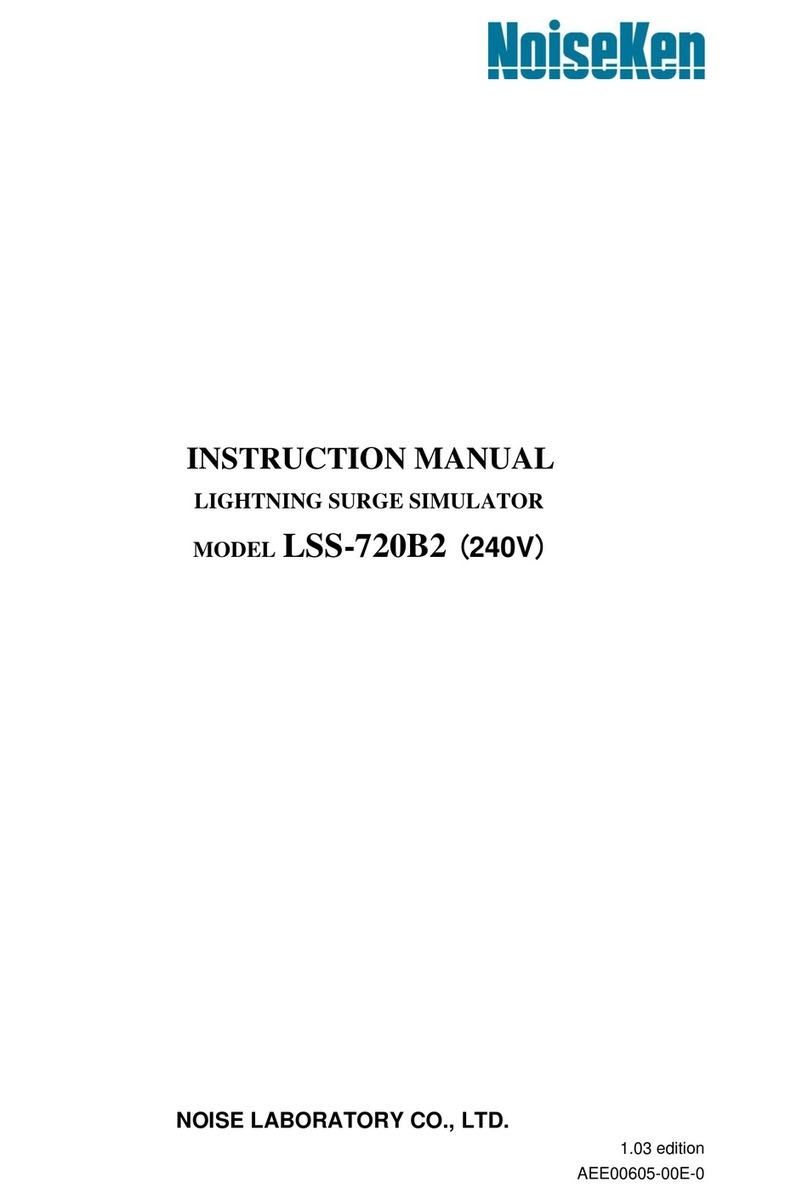
NoiseKen
NoiseKen LSS-720B2 instruction manual

Industrial Scientific
Industrial Scientific DS2 Docking Station Administrator's guide
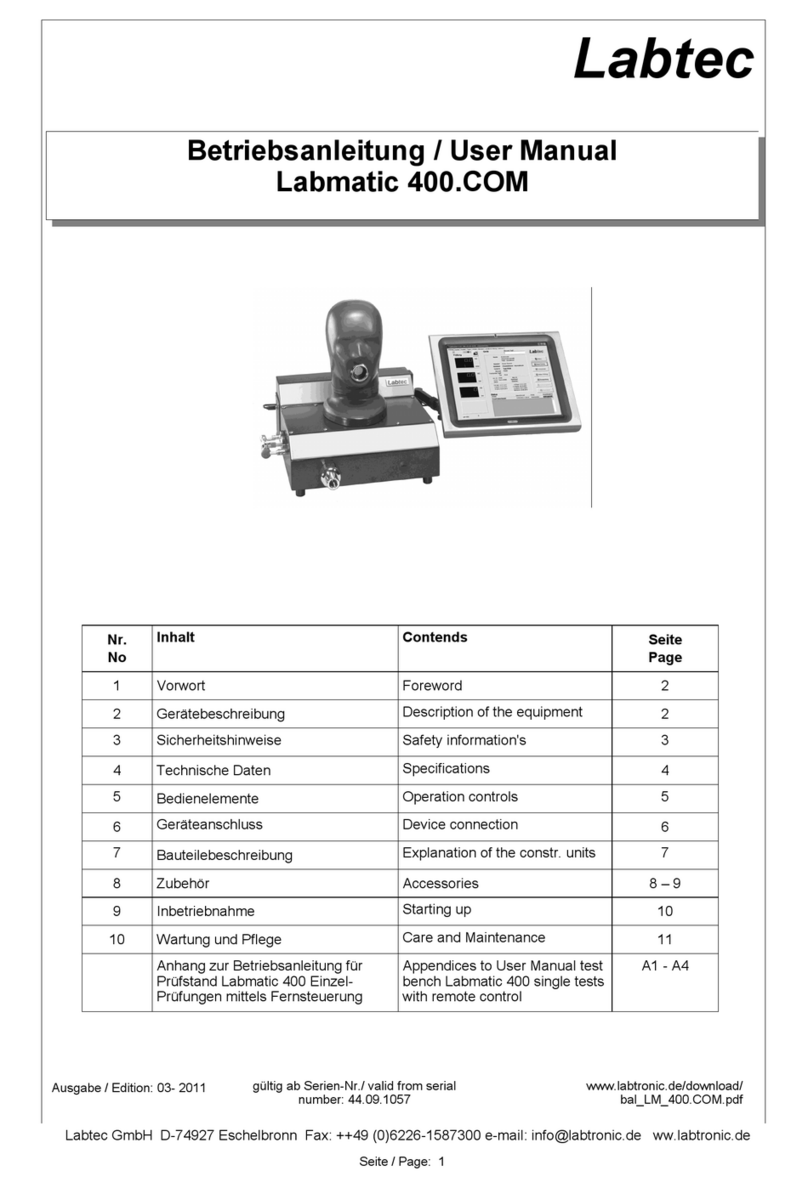
LABTEC
LABTEC Labmatic 400.COM user manual
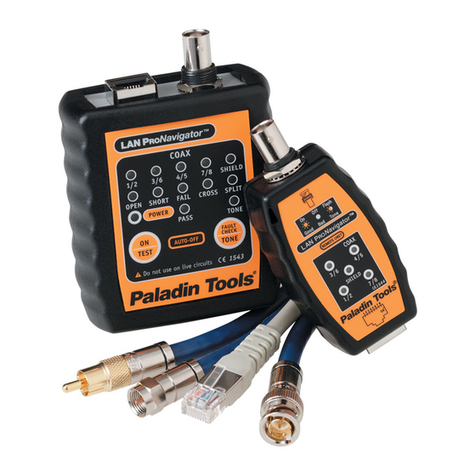
Paladin Tools
Paladin Tools LAN ProNavigator 1543 operating instructions
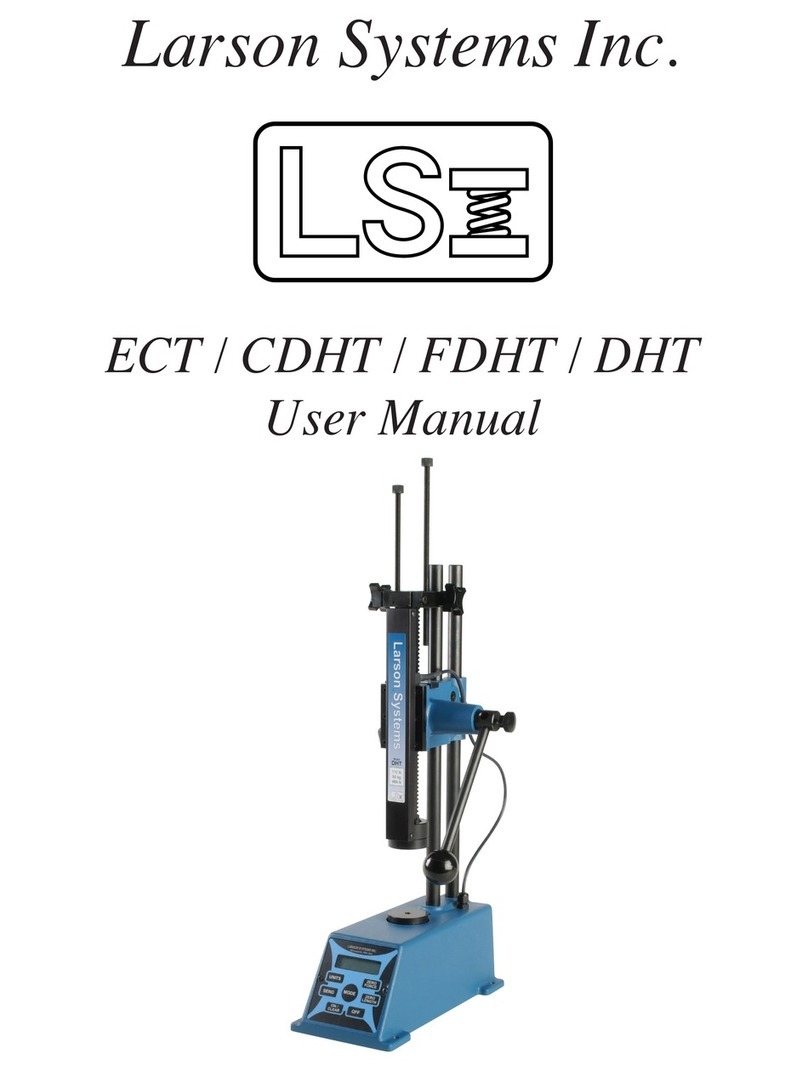
LSI
LSI ECT Series user manual
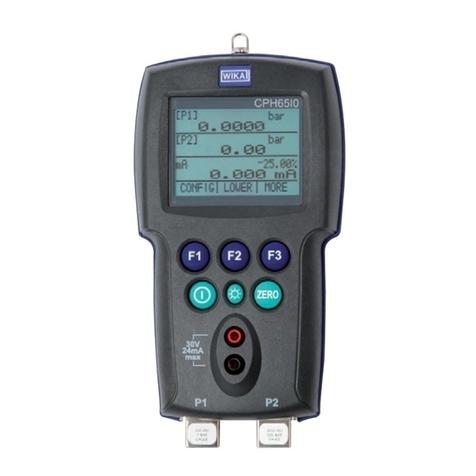
WIKA
WIKA CPH65I0 operating instructions
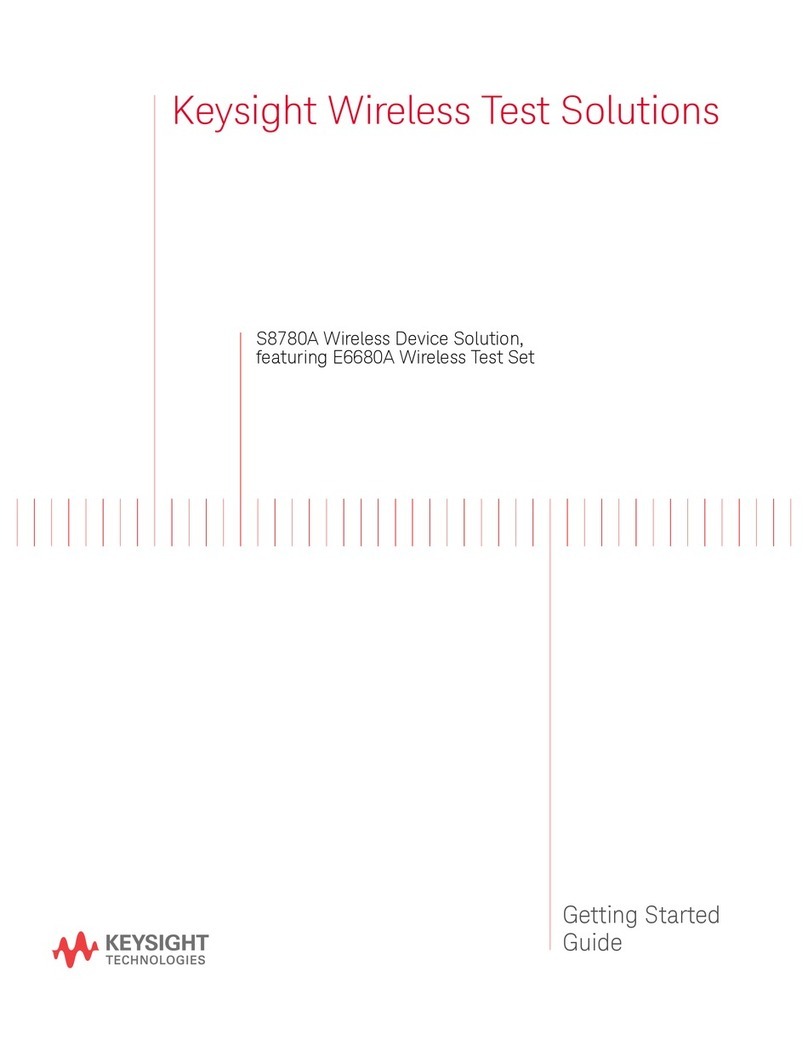
Keysight Technologies
Keysight Technologies S8780A Getting started guide
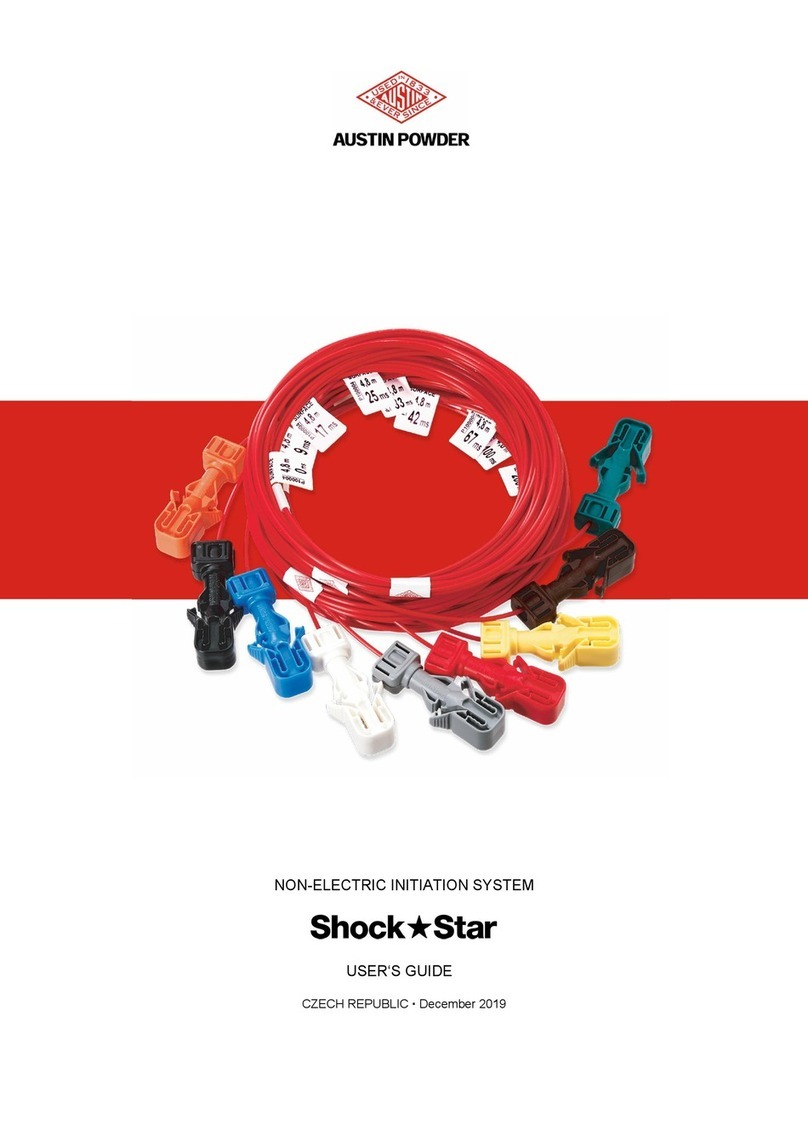
AUSTIN POWDER
AUSTIN POWDER Shock Star user guide
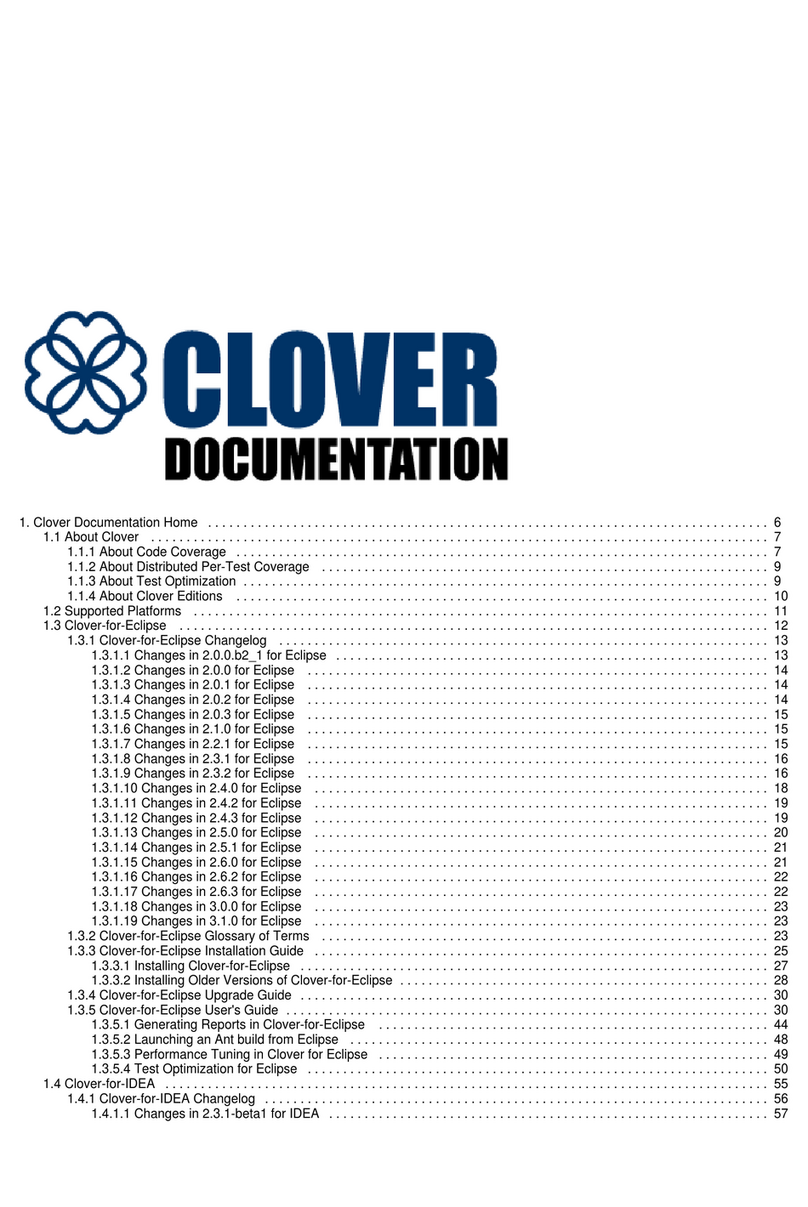
BIRD
BIRD AT-800 Operation manual
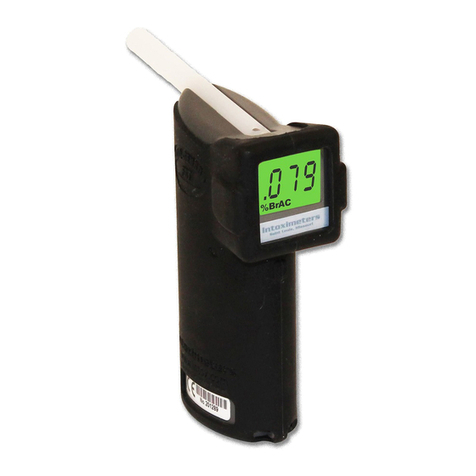
Intoximeters
Intoximeters Alco-Sensor FST Operator's manual
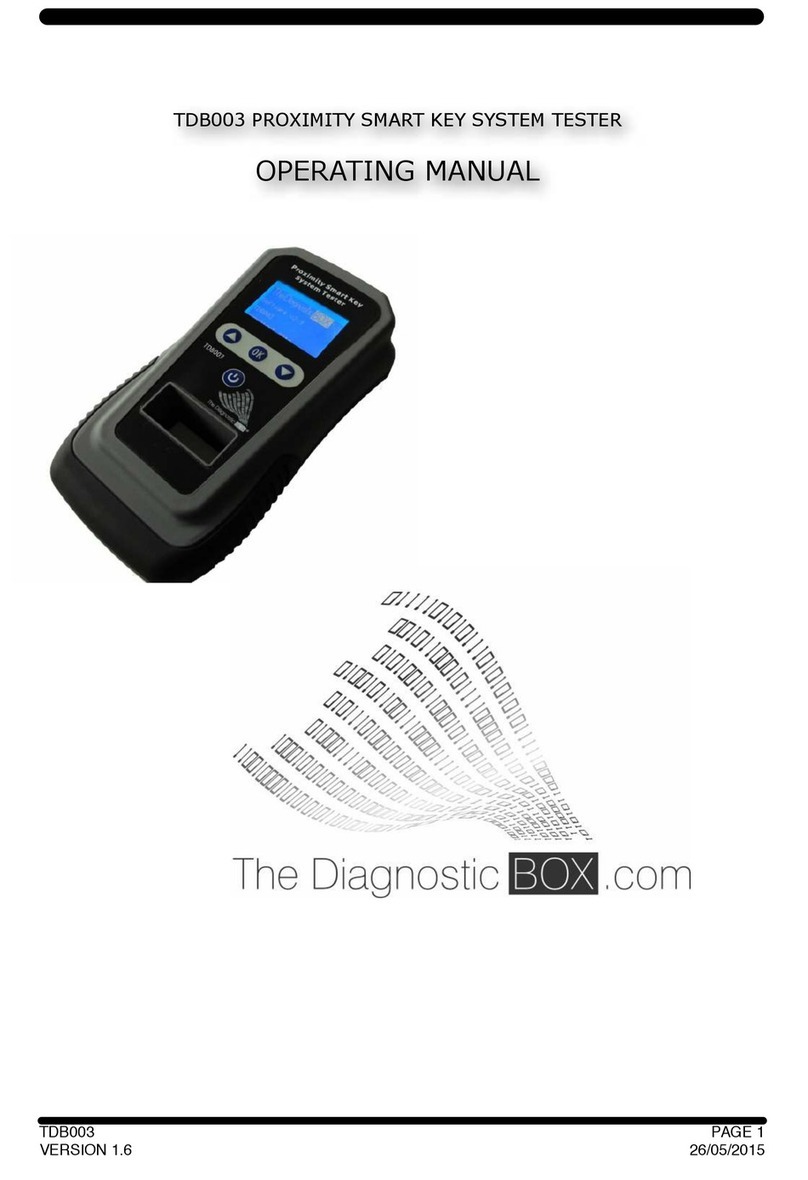
The Diagnostic Box
The Diagnostic Box TDB003 operating manual

Tru-Test
Tru-Test 702 user manual


